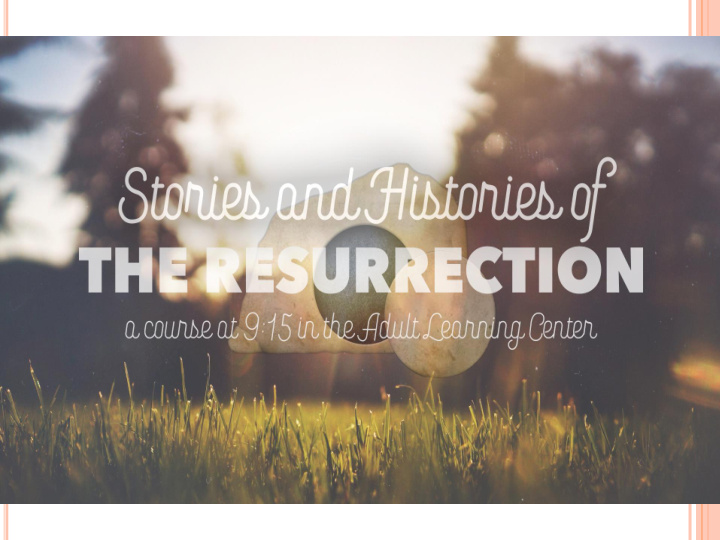



O PENING Q UESTIONS FOR J OHN Have you ever noticed how different the Gospel of John is from the other, synoptic, gospels? Why do you think it is so different? How do you understand those differences in the context of your understanding of Jesus?
O RPHEUS AND E URIDICE - E DWARD P OYNTER https://upload.wikimedia.org/wikipedia/commons/5/5d/Edward_Poynter_-_Orpheus_and_Eurydice.jpg
P ERSEPHONE , S YSIPHUS , AND H ADES http://www.theoi.com/image/K14.8Haides.jpg
P LATO ’ S M YTH OF E R http://www.ldysinger.com/@texts/0- 03_plato/x-last-judgm.jpg
T HE D EIFICATION OF J ULIUS C AESAR https://upload.wikimedia.org/wikipedia/commons/d/d7/Virgil_Solis_-_Deification_Caesar.jpg
N.T W RIGHT : S HADOWS , S OULS AND W HERE THEY G O “The great majority of the ancients believed in life after death; many of them developed, as we have seen, complex and fascinating beliefs about it and practices in relation to it; but, other than within Judaism and Christianity, they did not believe in resurrection. ‘Resurrection’ denoted a new embodied life which would follow whatever existence into which someone might (or might not) go immediately upon death; it was not a disembodied ‘heavenly’ life; it was a further stage, out beyond all that. It was not a redescription or redefinition of death. It was death’s reversal.
T HE G OSPEL OF J OHN Written in Ephesus probably around 90 CE – perhaps later. The Question of Authorship Literacy, life expectancy, occupation and social class The Disciple whom Jesus Loved Some Themes Highest Christology (Jesus as preexistent son sent from heaven) Lamb of God – “Here is the Lamb of God who takes away the sins of the world!” 1:29 Jesus dies on the day of preparation as the Passover lambs are being sacrificed. (Thursday)
M ORE T HEMES FROM J OHN Signs of Jesus’s identity (unique to John) Water into wine. Raising of Lazarus Lengthy conversations not recorded elsewhere Nicodemus: need to be born again, and John 3:16 Samaritan woman at the well. Lengthy discourses at the last supper Long philosophical discussion with Pilate Tentative Conclusions Most developed theology Greater conflict with Jews – the community had been excluded from the synagogue An invitation to a life of joy
T HE G OSPEL OF J OHN In the moments provided, silently read the passages for yourself. Note anything which stands out to you about the content. Then, reread the passage, using the questions on the handout on the table.
N. T. W RIGHT ON THE R ESURRECTION “’Believing in Jesus’s resurrection’ isn’t simply a matter of [acknowledging] that on the third day he rose again from the dead. . . . To say yes to Jesus’ resurrection is. . . . to say yes to the new world of forgiveness that was won on the cross, the world that was then launched into heaven-and-earth reality on Easter morning.”
N.T. W RIGHT C ONTINUED “Believing in Jesus’s resurrection is hard not merely because it’s difficult to get our minds around the idea of a person going through death and out into a new sort of bodily existence. . . It’s hard because we are asked to grasp or be grasped by the fact that a new reality, a new mode of existence, has been introduced to the world. This is at the heart of the ongoing revolution: that a new way of being human has been launched, a way that starts with forgiveness . . . That is what it looks like, sounds like, and feels like when heaven comes down to earth, when God’s kingdom comes and his will is done in the world of humans as it is in the world of angels.”
P ERILS AND P OSSIBILITIES OF EXPLORING CRITICAL SCHOLARSHIP More traditional view of faith Awareness of scholarly questions and issues Old Testament Today Daniel: Learning to Live in Exile Stories and Histories of the Resurrection Deconstruction of old view – can be emotionally and spiritually challenging. Reconstruction of a new view that incorporates some of the conclusions of scholarship What are we afraid of? “Do not be afraid.” History? Science? Archaeology? A richer, more nuanced view helps dispel fear.
Recommend
More recommend